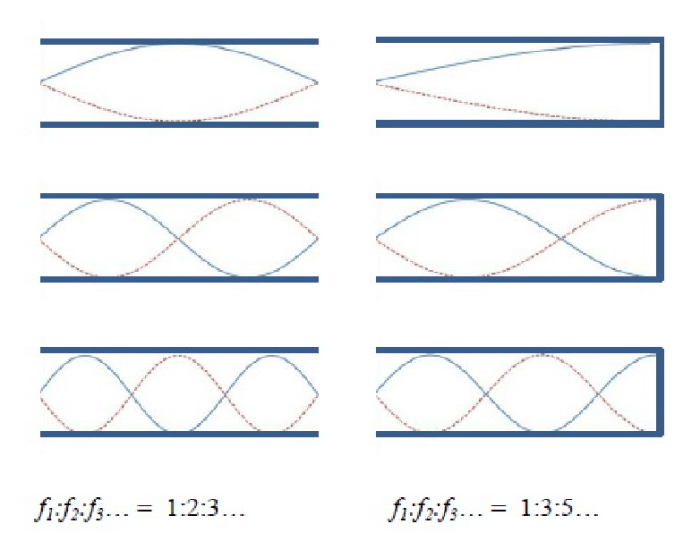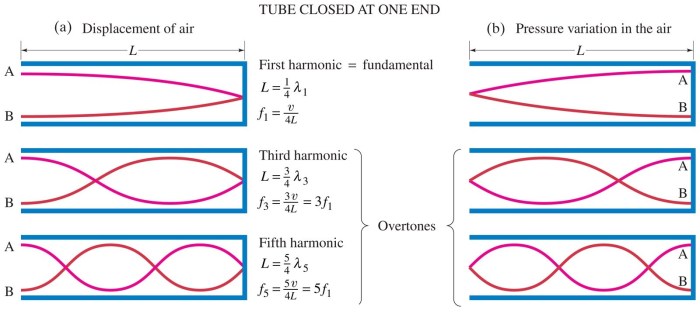For both waves on strings and sound waves in tubes – Waves on strings and sound waves in tubes are fascinating phenomena that exhibit unique properties and have diverse applications. This article delves into the fundamental characteristics, propagation, and practical uses of these waves, providing a comprehensive understanding of their significance in various fields.
From the intricate vibrations of guitar strings to the resonant frequencies of wind instruments, waves on strings and in tubes play a pivotal role in the world of sound and music. Their applications extend beyond the realm of entertainment, finding utility in communication systems, medical imaging, and more.
Wave Properties

Waves on strings and sound waves in tubes share fundamental properties that define their characteristics and behavior. These properties include:
- Wavelength (λ):The distance between two consecutive crests or troughs of a wave.
- Frequency (f):The number of waves passing a given point per unit time, measured in Hertz (Hz).
- Amplitude (A):The maximum displacement of a wave from its equilibrium position.
- Velocity (v):The speed at which a wave travels through a medium.
While sharing these properties, waves on strings and sound waves in tubes exhibit distinct characteristics. Waves on strings are transverse waves, where the displacement of the medium is perpendicular to the direction of wave propagation. In contrast, sound waves in tubes are longitudinal waves, where the displacement of the medium is parallel to the direction of wave propagation.
Wave Propagation
Waves on strings and sound waves in tubes propagate through their respective media in distinct ways.
Waves on strings:When a string is plucked or bowed, a disturbance is created, causing the string to vibrate. These vibrations generate waves that travel along the string, with the velocity determined by the tension and linear density of the string.
Sound waves in tubes:Sound waves in tubes, such as organ pipes or wind instruments, are generated by a vibrating source, such as a reed or vocal cords. These vibrations create pressure variations within the tube, which propagate as sound waves. The velocity of sound waves in a tube depends on the temperature and properties of the gas within the tube.
In both cases, the speed and direction of wave propagation are influenced by the properties of the medium and the boundary conditions.
Wave Interference
When two or more waves overlap, they can interfere with each other, resulting in constructive or destructive interference.
- Constructive interference:Occurs when the crests of two waves align, resulting in a wave with a larger amplitude.
- Destructive interference:Occurs when the crest of one wave aligns with the trough of another, resulting in a wave with a smaller amplitude or even complete cancellation.
Interference plays a significant role in shaping the amplitude and shape of waves on strings and sound waves in tubes. For example, in a guitar string, the interference of standing waves creates the characteristic harmonic overtones that give the instrument its distinct sound.
Wave Resonance
Wave resonance occurs when the frequency of a wave matches the natural frequency of a system, resulting in a significant increase in amplitude.
Musical instruments:Resonance is crucial in musical instruments. For example, in a stringed instrument, the body of the instrument resonates with the vibrating string, amplifying the sound. In a wind instrument, the length of the tube determines the resonant frequencies, which correspond to the different notes that can be played.
Wave Applications, For both waves on strings and sound waves in tubes
Waves on strings and sound waves in tubes have numerous practical applications:
- Musical instruments:The production of sound in musical instruments relies on the properties of waves on strings and sound waves in tubes.
- Communication systems:Sound waves are used in communication systems, such as telephones and loudspeakers.
- Medical imaging:Ultrasound, which utilizes sound waves, is used in medical imaging to visualize internal organs and structures.
General Inquiries: For Both Waves On Strings And Sound Waves In Tubes
What is the difference between waves on strings and sound waves in tubes?
Waves on strings are transverse waves, meaning their particles vibrate perpendicular to the direction of wave propagation. Sound waves in tubes are longitudinal waves, meaning their particles vibrate parallel to the direction of wave propagation.
How does wave interference affect the sound produced by musical instruments?
Wave interference can create constructive or destructive interference, which can enhance or diminish the sound produced by musical instruments. For example, the resonance of a guitar string is caused by constructive interference of standing waves.
What are some practical applications of waves on strings and sound waves in tubes?
Waves on strings are used in musical instruments, such as guitars, violins, and pianos. Sound waves in tubes are used in wind instruments, such as flutes, clarinets, and trumpets. Both types of waves are also used in communication systems, such as telephones and loudspeakers.


